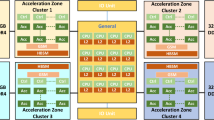Abstract
A computational model of associative type is proposed. For it a program is written which does not contain loops and has the following properties. The program's original data are a normal algorithmA (its notation) and a worda, while the results are a Boolean value
and a wordR. IfA is applicable to worda, then we can indicate a finite memory such that the program, having worked on this memory, yields the valuetrue as
andA(a) asR. However, ifA is not applicable toa, then the program does not work on any (finite) memory and always yields the valuefalse as
, If the program works on an infinite memory, then after its work
takes the valuetrue if and only ifA is applicable toa; moreover, in the case of applicabilityR takes the valueA(a). The present paper contains a more detailed exposition of the result published in Zap. Nauchn. Sem. Leningr. Otd. Mat. Inst. Akad. Nauk USSR,70 (1977).
Similar content being viewed by others
Literature cited
A. N. Myamlin and A. A. Sosnin, “Supercomputers: architecture and areas of application,” Preprint, No. 15, Inst. Prikl. Mat., Moscow (1977).
D. H. Enslow (ed.), Multiprocessors and Parallel Processing, Wiley, New York (1974).
I. V. Prangishvili (ed.), Homogeneous Microelectronic Associative Processors [in Russian], Moscow (1973).
Ya. I. Fet, Mass Processing of Information in Specialized Homogeneous Processors [in Russian], Novosibirsk (1976).
A. S. Narin'yani, “Theory of parallel programming. Formal models. I,” Kibernetika, No. 3, 1–15 (1974).
A. S. Narin'yani, “Theory of parallel programming. Formal models. II,” Kibernetika, No. 5, 1–14 (1974).
M. S. Burgin and A. Yu. Karasik, “Analysis of one abstract model of computing systems,” Programmirovanie, No. 1, 72–82 (1975).
M. S. Burgin and A. Yu. Karasik, “Operators of a multidimensional structure-oriented parallel-processing model,” Avtomat. Telemekh., No. 8, 179–185 (1976).
G. M. Popova and I. V. Prangishvili, “Associative parallel processor for group processing of data,” Avtomat. Telemekh., No. 1, 171–184 (1972).
V. N. Aleeva and Ya. I. Fet, “Associative processor for large-block processing of information. Optimization,” Sb. Tr. Inst. Mat. Sib. Otd. Akad. Nauk SSSR, No. 15(32), 154–177 (1974).
Y. Chu, Computer Organization and Microprogramming, Prentice-Hall, Englewood Cliffs, New Jersey (1972).
M. M. Lebedinskii, “On the possibilities of carrying out parallel processing on a three-dimensional associative parallel processor,” Zap. Nauchn. Sem. Leningr. Otd. Mat. Inst.,70, 140–160 (1977).
Additional information
Translated from, Zapiski Nauchnykh Seminarov Leningradskogo Otdeleniya Matematicheskogo Instituta im. V. A. Steklova AN SSSR, Vol. 90, pp. 83–149, 1979.
In conclusion, the author thanks K. V. Shakhbazyan for constant attention to the work.
Rights and permissions
About this article
Cite this article
Lebedinskii, M.M. Possibility of maximum paralleling of problems on associative processors. J Math Sci 20, 1959–2011 (1982). https://doi.org/10.1007/BF01680566
Issue Date:
DOI: https://doi.org/10.1007/BF01680566




